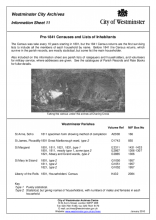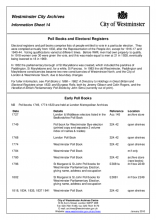Finding your ancestors
Discovering where your ancestor lived can help you trace your family tree. Census records, electoral registers, poll books, trades directories and rate books can all provide further information.
Trade directories
London directories lists individuals and where they lived. They mainly list people involved in trade, commerce and the professions, and, as people had to pay to be listed, they are far from comprehensive.
However, they predate the first useful census returns of 1841, and, as time went on they began to include short histories, details of schools, hospitals, local officials, and more.
Trade directories are also useful as they post-date the 1891 census and continued to be produced until 1991.
They can be also be used as a name index to the census returns. Directories up to 1816 have alphabetical list of names only.
From 1817 onwards odd years do contain street directories. From 1855 the principal separate sections of Kelly's Directories are streets, commercial (tradesmen listed alphabetically), trades (tradesmen listed by profession) and court (people of social standing listed alphabetically).
Our holdings of London Directories, 1736 to 1991 are available on microfilm. We also hold 3 series of local directories for St Marylebone, Paddington and Pimlico dating from the mid-19th century to the mid-20th century.
View a complete list of our holdings
Historical Directories is a searchable digital library compiled by Leicester University of selected local and trade directories for England and Wales from 1750 to 1919.
Court guides
View a complete list of our holdings
Rate books
The first poor rate was imposed by an act of 1597 to 1598 and rate books were compiled to keep a record of each person's assessment and whether or not it had been paid.
As well as rates taken to pay for the relief of the poor, rates were also levied for the repair and maintenance of highways, the parish watch, sewers and general improvements.
Rate books give the names of rate payers listed by street, and detail the amount of rates paid. The rate payer is the person paying the local taxes and can be the occupier or owner of the house.
The books can be used to establish how long someone was at a particular address and are often available from the start date of a building or first occupation of a street.
Our collection starts in the 16th century and runs to 1968. There is an index by street to both St Marylebone and Westminster.
Unfortunately, there is no street index to the Paddington rate books and only one set of rate books every 10 years is extant for the parish and Metropolitan Borough of Paddington from 1860 to 1910.
Apart from this, virtually all rate books have survived, making this one of the most reliable sources we have. Our information sheet on pre-1841 censuses provides a full list of our holdings, as does our council records webpage.
Electoral registers and poll books
Poll books can show where your ancestors lived and their political inclinations.
Prior to 1832, there was no fixed qualification and franchise eligibility depended on local circumstances and tradition. It was generally linked to ownership of land, by men over 21, of property worth £10 or more a year. Only about 1 in 10 men and no women could vote.
Poll books were published from 1696 right through to the 1872 Ballot Act when secret voting was introduced.
The information contained usually includes the person's name and who they voted for, and sometimes address and occupation.
View a full details of our poll books collection
The 1832 Reform Act extended the franchise, and lists of people entitled to vote in local or parliamentary elections have been compiled every year since then (apart from during the two World Wars).
They can be used in conjunction with rate books to establish how long someone was living at a particular address and are especially useful as they list all of the residents who are entitled to vote, not just the head of household.
There were voting restrictions, for example women over the age of 30 were only given the vote in 1918 and women over 21 in 1928. Remember that only British citizens have the right to vote so other nationalities are not listed.
Our collection of electoral registers is far from complete for the years 1832 to 1900, For the old City of Westminster (South Westminster) the complete series begins in 1906. The St Marylebone area series begins in 1918 and the Paddington area series begins in 1902.


